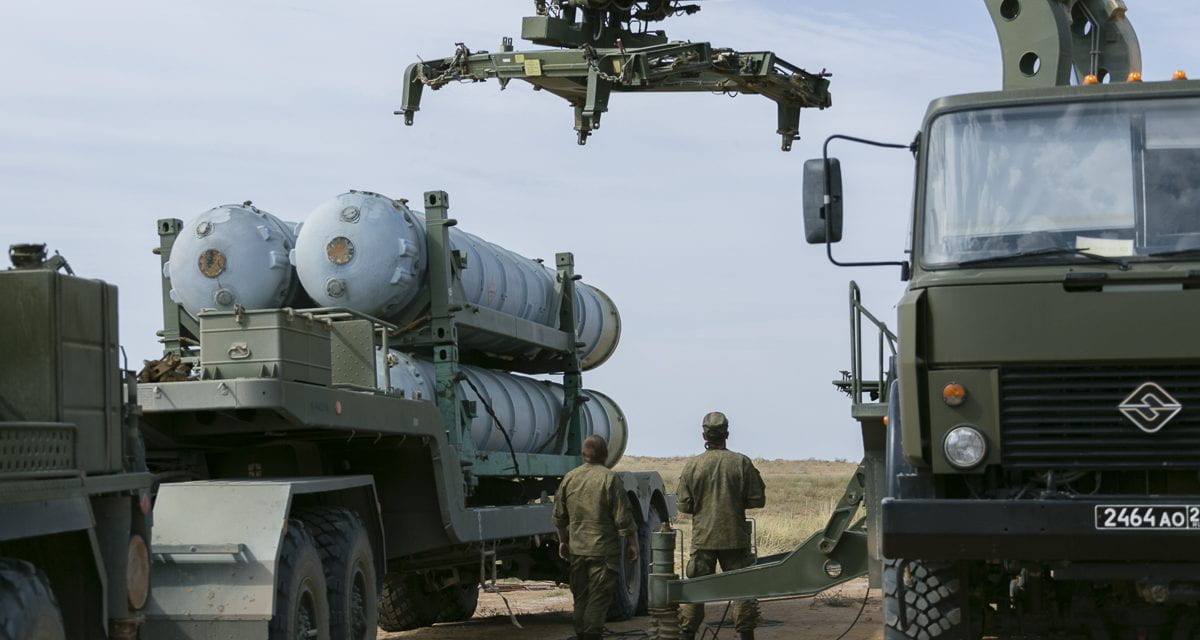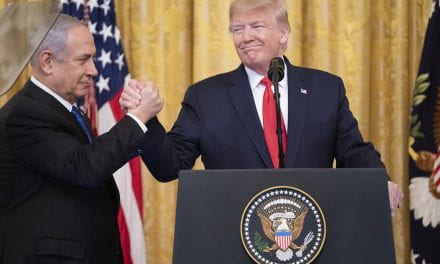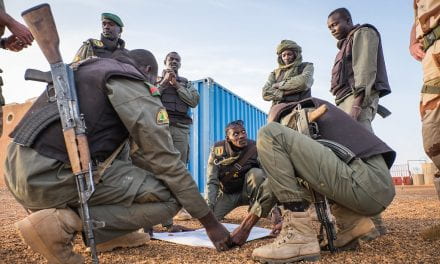The current Turkish President, Recep Tayyip Erdogan, has put Turkey’s reputation as a reliable political and military ally in jeopardy. In particular, Turkey’s importation of Russia’s S-400 system sends the message that Turkey is willing to collaborate with players that undermine the role of NATO, notably Russia, for short term gains. However, NATO’s failure to provide a proper missile defense system for Turkey, along with troop withdrawals, has made Turkey more vulnerable to an increasingly antagonistic Syrian government. In response, Turkey has acted against the interest of its NATO members by escalating its aggression against Syria and integrating a Russian S-400 missile defense system into its military. Turkey’s actions not only threaten to further destabilize the Turkish-Syrian border region, but also intensifies tensions between Russia and NATO.
Four years prior to Turkey’s arms deal with Russia, NATO members withdrew many troops and their own missile defense systems from the region. In a NATO press conference in 2014, General Jens Stoltenberg laid out the plans and objectives of NATO, stating that NATO as an organization would not assist Turkey with its refugee crisis.[1] In August 2015, the US also announced that it would temporarily withdraw its Patriot missile defense system from Turkey for upgrades. The US’s decision to withdraw the Patriot system came a day after Germany announced it would withdraw some 250 troops from Turkey. The German troops were put in Turkey in 2013 to protect Turkey from shells fired from Syria. The troops were withdrawn because the main threat in the region was the Islamic State, which did not possess missiles.[2] The decision by NATO allies to reduce their support in Turkey might have given President Erdogan the incentive to rely on other regional players, like Russia, to bolster its defense. However, Russia seems to be playing both sides, Turkish and Syrian, as it attempts to earn a more important role in the region by providing not only military equipment, but also aerial support for Syria.
In April of 2018, the Syrian government launched an aerial and ground offensive, with Russian support, into Idlib in order to reoccupy territory captured by Turkish-backed rebel groups. By September 2018, Russia brokered a ceasefire between Turkey and the Syrian government in the Sochi Agreement.[3] The agreement also put in place a 20-kilometer buffer zone between Turkish-backed rebel groups and the Syrian regime in order to deescalate tensions. However, over the next several months the Syrian government, with Russian air support, launched an offensive against rebel forces within and around the buffer zone, without discrimination between civilians and military personnel. The main city that was involved in this new offensive was Idlib. The assault on Idlib led to 420 civilians killed and 400,000 displaced shortly after. Since the new offensive of the Syrian government began, there have been 900,000 individuals displaced to date.[4]The use of Syrian aerial bombardment along the Turkish border leaves Turkey with a great desire to implement a substantial missile air defense system that NATO hasn’t been able to provide.
The importation of a new S-400 surface to air missile system by Turkey from Russia not only fractures past political allegiances but also put the future of these political partnerships in jeopardy. The purchase of the S-400 system cost Turkey about 2.5 billion USD.[5] The first components of the system arrived on 12 July at Murted Air Base in Ankara. In November 2019, Turkey conducted tests of the system. Turkey chose to purchase the S-400 system despite the fact that the American Patriot system costs about the same amount as the Russian system and implementing it would not have resulted in subsequent political tensions between Turkey and its NATO allies. Erdogan has expressed some interest in purchasing the Patriot air defense system, but believes that the complete removal of the S-400 would be acting against the Turkey’s sovereign right to protect its own borders.[6] Erdogan’s sentiments are likely a result NATO’s gradual withdrawals from Turkey since 2015 which left it vulnerable to possible security risks on its southern border with Syria. NATO’s distancing from Turkey as well as Turkey’s purchase of the S-400 system are emblematic of the increasingly divergent military and political objectives of Turkey and NATO with regards to Syria.
The integration of the S-400 system would potentially compromise the security and eventual usage of F-35 jets within the militaries of NATO allies. On 12 July 2019, a NATO official told the Washington Post that the alliance was “concerned about the potential consequences of Turkey’s decision.” [7] Although, Turkey said that it wouldn’t allow Russian officials to access F-35 technology. NATO’s official response was that Turkey’s decision to intergrade and purchase the Russian system was against the wishes of many members. According to the General Secretary of NATO, Jens Stoltenberg, the Russian S-400 system “will never be a part of the NATO Integrated Air and Missile Defense System.”[8] Even though the S-400 system won’t be integrated into the NATO’s own defense network, this does not effectively address the problem of a NATO ally using a Russian engineered missile defense systems.
While NATO as an organization has not implemented joint and unilateral measures against Turkey for its integration of the S-400 system, individual member states like the US have decided to reduce their military support for Turkey. For example, on 10 July 2019, the US Department of Defense cancelled its supply of around 100 F-35 stealth fighter jets to Turkey because it was concerned that Turkey might give Russia some level of access to F-35 technology while installing the S-400 system.[9] However, the US Department of Defense stated that it would be willing to renew its supply of F-35 jets to Turkey if it backs off of its commitments to the implementation of the S-400 system. The acting assistant Secretary of Defense for international security affairs, Katie Wheelbarger, said that all NATO members that have implemented the F-35 are unified in their opposition to the Russo-Turkish arms deal.[10] The integration of the S-400 system into Turkey’s missile defense network has the very real potential to compromise the security of any state that utilizes F-35 jets. However, it seems as if Turkey is willing to gamble its relationship with NATO members in order to fortify against what it sees as a regional rival, Syria.
The border region between Turkey and Syria was further destabilized after the withdrawal of US troops and support for Kurdish forces in Northern Syria and it has only emboldened Turkey to take more aggressive military action in Syria. In December 2018, President Trump announced that the US would pull its troops out of Northern Syria and by October 2019, the US took the first concrete steps in withdrawing its troops from Northern Syria. The withdrawal only included taking out 50 special operators from Syria’s west northern region. Even though there were only 50 US special operators in Syria, their presence most likely deterred the Turkish and Syrian military from taking any sort of major offensive that would endanger American lives.[11] With the US’s troop withdrawal, Turkey sees itself as even more vulnerable to Syrian missile and aerial attacks and is also now free to remove Kurdish forces such as the SDF, from Northern Syria. Since 2014, the US provided support for SDF in Northern Syria with the purpose of defeating Islamic State. The SDF is numbered at around 36,000 troops consisting of both Arabs and Kurdish fighters and has grown to become an important regional player in the fight against Islamic State.[12] The same month as the US troop withdrawal, Turkey launched an air and ground assault against the Syrian militia SDF.
Turkey’s offensive against Kurdish forces in northeastern Syria has stoked further military tensions with the Syrian government. Erdogan justified the actions of the Turkish offensive because its purpose was to “prevent the creation of a terror corridor” across Turkey’s southern border.[13] The Communications Director of Turkey also commented that Turkey only wanted to “neutralize a longstanding threat against Turkish citizens” and to rid the region of “armed thugs.”[14] Turkey’s inherent and numerous hostilities with neighboring states, ethnic groups, and military organizations place barriers to the US and NATO’s goal of eventually distancing themselves from the region militarily. The Turkish military has already launched operations in Northern Syria as a response to Syrian air strikes that killed 34 Turkish soldiers in Idlib on 27 February 2019. By 1 March, Turkish Defense Minister Hulusi Akar announced that with the launch of Operation “Spring Shield” Turkey would regain control of Northern Syria and would serve as a response to Syria’s air strike on the Turkish soldiers in Idlib.[15] The same day, the Turkish Defense Ministry announced that it had shot down two Syrian SU-24 aircraft in northwestern Idlib.[16] Turkey’s growing military tensions with Syria and Kurdish forces in the region threaten to also increase hostilities between the US, NATO, and Russia.
If Turkey does not attempt to normalize its relationship with NATO, then it becomes more of a weak link for the organization than an actually beneficial member. President Erdogan has shifted Turkey’s international political and military stance closer to NATO adversaries and against its allies’ interests. The fact that Turkey has been able to import the S-400 system with minimal NATO repercussions means that the organization does not have any sort of system in place to discipline its members when they act in a fashion that runs against NATO’s traditional goals and general sentiments. Withdrawal of foreign NATO troops from norther Syria and the presence of Kurdish forces in the same region gives Turkey the precedent, from its point of view, to retake indirect control over Idlib. However, the increasing frequency and intensity of Syria-Turkey aerial and ground conflicts has pushed Turkey to go against NATO’s wishes. Turkey’s military campaigns in Northern Syria threatens to further destabilize an already volatile region and also raises the potential for a major military conflict between NATO and Russia.
[1] “Press Conference by Incoming NATO Secretary General Jens Stoltenberg.” North Atlantic Treaty Organization (NATO), North Atlantic Treaty Organization (NATO), 1 Oct. 2014, www.nato.int/cps/en/natohq/opinions_113488.htm?selectedLocale=en.
[2] Associated Press (AP). “US to Withdraw Patriot Missile System from Turkey.” AP NEWS, Associated Press, 16 Aug. 2015, apnews.com/d32616edab76446e9489493f66b05b7f.
[3] Linick, Steve A, editor. Operation Inherent Resolve. U.S. Department of Defense, 2019.
[4] Ibid.
[5] Reuters. “Turkey’s First S-400 Shipment Arrives as a Second Is Planned for Ankara.” The Moscow Times, The Moscow Times, 2 Mar. 2020, www.themoscowtimes.com/2019/07/25/turkeys-first-s-400-shipment-arrives-as-a-second-is-planned-for-ankara-a66577.
[6] Woody, Christopher. “It’s Getting Harder for NATO to Hide That Turkey’s Becoming ‘a Thorn in Everyone’s Side’.” Business Insider, Business Insider, 2 Dec. 2019, www.businessinsider.com/turkey-tests-russian-made-s400-with-f16s-despite-us-warnings-2019-11.
[7] O’Grady, Siobhán. “What Is the Russian S-400 Air Defense System, and Why Is the U.S.Upset Turkey Bought It?” The Washington Post, WP Company, 17 July 2019, www.washingtonpost.com/world/2019/07/12/what-is-russian-s-air-defense-system-why-is-us-upset-turkey-bought-it/.
[8] Ibid.
[9] “Press Conference by NATO Secretary General Jens Stoltenberg Following the Meeting of the North Atlantic Council at the Level of Heads of State and/or Government.” North Atlantic Treaty Organization (NATO), North Atlantic Treaty Organization (NATO), 4 Dec. 2019, www.nato.int/cps/en/natohq/opinions_171554.htm?selectedLocale=en.
[10] Garamone, Jim. “Turkey Must Drop Russian S-400 to Stay in F-35 Program, DOD Officials.” U.S. Department of Defense, U.S. Department of Defense, 10 July 2019, www.defense.gov/Explore/News/Article/Article/1901219/turkey-must-drop-russian-s-400-to-stay-in-f-35-program-dod-official-says/.
[11] Garamone, Jim. “Trump Takes Steps to Ensure Safety of U.S. Special Operators in
Syria.” U.S. DEPARTMENT OF DEFENSE, Department of Defense, 8 Oct. 2019, www.defense.gov/Explore/News/Article/Article/1984105/trump-takes-steps-to-ensure-safety-of-us-special-operators-in-syria/.
[12] Ibid.
[13] Hubbard, Ben, and Carlotta Gall. “Turkey Launches Offensive Against U.S.-Backed Syrian
Militia.” The New York Times, The New York Times, 9 Oct. 2019, www.nytimes.com/2019/10/09/world/middleeast/turkey-attacks-syria.html.
[14] Hubbard, Ben, and Carlotta Gall. “Turkey Launches Offensive Against U.S.-Backed Syrian Militia.” The New York Times, The New York Times, 9 Oct. 2019, www.nytimes.com/2019/10/09/world/middleeast/turkey-attacks-syria.html.
[15] Iddon, Paul. “Operation Spring Shield: How Far Will Turkey’s Latest Syria Offensive
Go?” Rudaw.net, Rudaw, 2 Mar. 2019, www.rudaw.net/english/middleeast/syria/020320201.
[16] Ibid.






